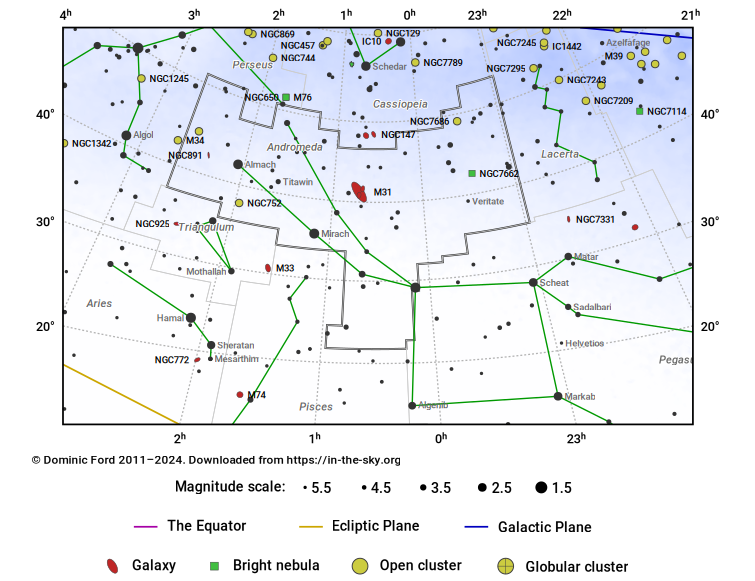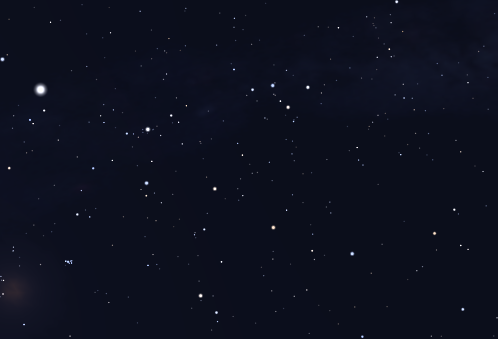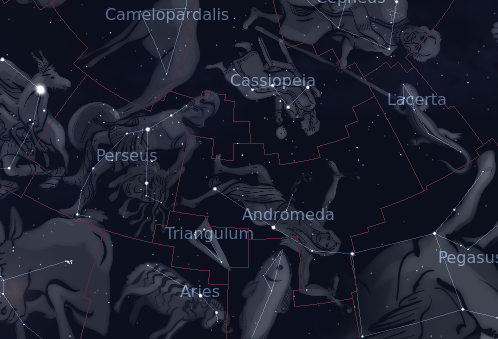The Constellation Andromeda
Andromeda is a large northern constellation, visible in the months around September.
It is home to one of the best-known of all deep-sky objects, the Andromeda Galaxy, M31, which is the nearest comparably-sized galaxy to our own Milky Way. Around M31 can be seen a number of smaller companion galaxies, including M32 and M110.
Lying not far from the plane of the northern Milky Way, Andromeda is also home to numerous open clusters.
Andromeda's brightest star, Alpheratz forms one corner of the Square of Pegasus, and was once shared between the two constellations with the designations α–And and δ–Peg. Today it is assigned exclusively to Andromeda, and the designation δ–Peg is defunct.
In Greek mythology, Andromeda was the daughter of King Cepheus and Queen Cassiopeia. She was chained to a rock as a sacrifice, after the god Poseidon had sent a sea monster – sometimes associated with the constellation Cetus – in retribution for Cassiopeia's boastfulness.
She was rescued by Perseus, whom she married.
Ancient
1.8% of the sky
722.3 square degrees
The following constellations neighbor Andromeda: Andromeda, Cassiopeia, Lacerta, Pegasus, Perseus, Pisces, Triangulum.
Hover the pointer over the name of an object to highlight its position on the starchart to the right, or click to see more information.
| Stars | Open Clusters | Globular Clusters | Galaxies |
| Alpheratz (mag 2.1) | NGC 7686 (mag 5.6) | Messier 31 (mag 3.4) | |
| Mirach (mag 2.1) | NGC 752 (mag 5.7) | Messier 110 (mag 8.2) | |
| Almach (mag 2.2) | NGC 956 (mag 8.9) | Messier 32 (mag 9.0) | |
| δ-And (mag 3.3) | NGC 272 | NGC 891 (mag 9.9) | |
| 51-And (mag 3.6) | NGC 404 (mag 10.6) | ||
| O-And (mag 3.6) | NGC 7640 (mag 11.0) | ||
| λ-And (mag 3.9) | IC 239 (mag 11.2) | ||
| μ-And (mag 3.9) | NGC 529 (mag 12.1) | ||
| ζ-And (mag 4.1) | NGC 214 (mag 12.2) | ||
| Titawin (mag 4.1) | NGC 828 (mag 12.2) | ||
| κ-And (mag 4.1) | NGC 910 (mag 12.2) | ||
| ι-And (mag 4.3) | NGC 80 (mag 12.3) | ||
| φ-And (mag 4.3) | NGC 536 (mag 12.4) | ||
| π-And (mag 4.3) | NGC 753 (mag 12.4) | ||
| ε-And (mag 4.4) | NGC 252 (mag 12.5) | ||
| η-And (mag 4.4) | NGC 818 (mag 12.5) | ||
| σ-And (mag 4.5) | NGC 687 (mag 12.5) | ||
| ν-And (mag 4.5) | NGC 393 (mag 12.5) | ||
| 7-And (mag 4.5) | NGC 679 (mag 12.5) | ||
| θ-And (mag 4.6) | NGC 83 (mag 12.6) | ||
| 3-And (mag 4.6) | IC 179 (mag 12.6) | ||
| 65-And (mag 4.7) | NGC 797 (mag 12.6) | ||
| 58-And (mag 4.8) | NGC 160 (mag 12.7) | ||
| ω-And (mag 4.8) | NGC 304 (mag 12.7) | ||
| 8-And (mag 4.8) | NGC 812 (mag 12.7) | ||
| γ²-And (mag 4.8) | NGC 759 (mag 12.7) | ||
| b-And (mag 4.8) | NGC 183 (mag 12.7) | ||
| Adhil (mag 4.9) | NGC 906 (mag 12.9) | ||
| τ-And (mag 5.0) | NGC 68 (mag 13.0) | ||
| HIP 7918 (mag 5.0) | NGC 668 (mag 13.1) |




